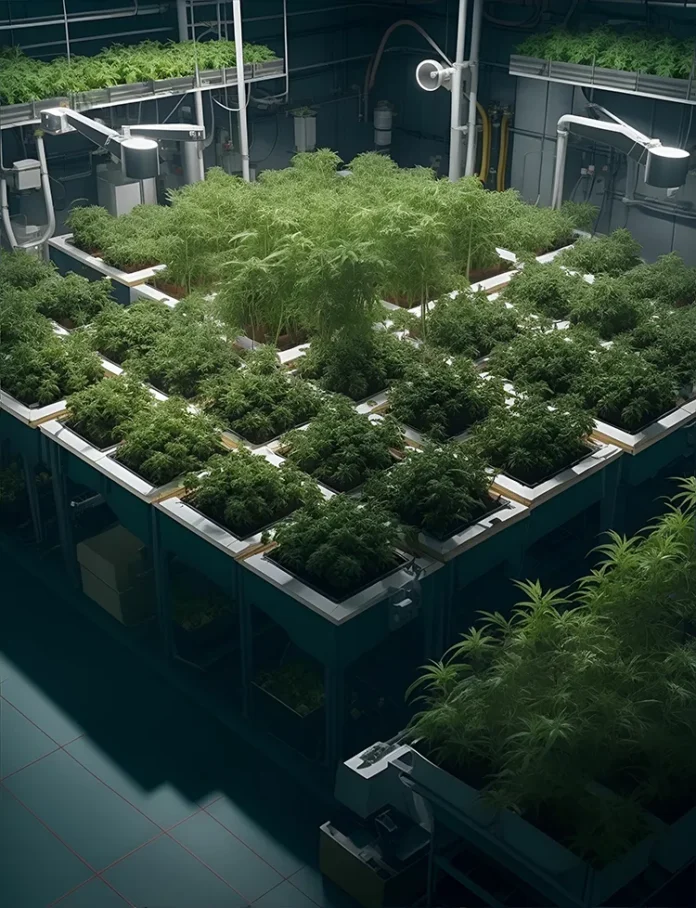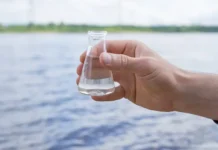By Liz Stevens, writer, UV Solutions
The use of Cannabis sativa L., whether the industrial hemp variety, the medical variety or the recreational variety, is on the rise. Revenue in the US from cannabis sales is projected to reach nearly $42B in 2024, with significant growth expected in the years to come. While it still is a Schedule I illegal substance under federal law, the US states have a smorgasbord of laws and regulations. Policy in the states ranges, for example, from a “no public cannabis access” stance in Idaho, to a “CBD/low THC” program in Wyoming, to approval for “adult and medical use” in Colorado and to a comprehensive medical program in Utah. The regulations covering quality and safety for cannabis are in their infancy and even more of a patchwork, with mandates sometimes copied verbatim from policies designed for food and pharmaceuticals.
Cannabis is a surprisingly complex plant that offers a long list of uses and benefits, along with an array of potential health risks for some users. The value of the plant’s pharmaceutical compounds has been highlighted in studies evaluating the effect of cannabis on diseases such as cancer, multiple sclerosis and acquired immune deficiency syndrome. It may be useful for the production of biofuels like biodiesel and bioethanol. Cannabis seeds have nutritional value, and the plant is a trove of phytochemicals that are valuable for pharmaceutical use. 1
The plant’s complex makeup includes a wide variety of chemical compounds and plant secondary metabolites that are the basis for its recreational appeal and for medical applications. The metabolites include terpenes, flavonoids and cannabinoids like Δ9-tetrahydrocannabinol (Δ9-THC), which give cannabis its “high” and reportedly is valuable for its anticancer, antibacterial, antiemetic and analgesic action, among other uses. 2
Scientists have found an equally complex makeup of contaminants and pathogens that can affect cannabis, including pesticides, inorganics, solvents, microbes and mycotoxins. While insecticides and fungicides seem to be the most prevalent category of contaminants detected in cannabis, the fungi and mycotoxin contaminants being found are arguably the most worrisome, especially for a large class of cannabis users – medical patients using cannabis who may be immunocompromised and at a high risk for fungal and mycotoxin infections. 3
Science still is in the investigative stage of discovering the plant’s useful qualities, and in identifying and understanding the pathogens that can affect cannabis. UV exposure is being studied for its ability to enhance overall plant growth, to increase the yield of the crop’s most valuable parts (its inflorescences or flowering parts) and to strengthen its desirable secondary metabolite characteristics. Researchers also are exploring the use of UV against pathogens in living plants and experimenting with electron beam (EB) as a post-harvest decontaminant.
Pre-harvest use of UV
Pre-harvest strategies for eliminating pathogens or enhancing sought-after cannabis characteristics with UV have not been explored and vetted in a rigorous way, leaving growers and researchers mostly in the dark as to the value of applying UV exposure to living plants. Some researchers have studied UV-C, while others focused on UV-A or UV-B. The most thorough recent study evaluated the impact of UV-A, as well as the impact of UV-A plus UV-B.
In “Integrated Management of Pathogens and Microbes in Cannabis sativa L. (Cannabis) under Greenhouse Conditions,” 4 authors Liam Buirs and Zamir K. Punja cite the use of UV-C treatment to support cannabis plant health in the vegetative stage, and the use of irradiation (such as electron beam) for decontamination of plant parts in the post-harvest processing stage. In a common scenario, in which cannabis cultivars have been bred for greater THC content and to increase the number and size of inflorescences rather than for having natural pathogen resistance, growers must make up for the plant’s now limited natural defenses with external strategies and remedies.
UV-C, it appears, can be an effective way to handle certain pathogens on the surface of plant parts. “On the foliage, the exposure of plants to ultraviolet radiation, especially UV-C light (234 nm wavelength), can suppress powdery mildew mycelium development and spore germination when applied routinely at an appropriate dosage with good coverage of the upper leaf surfaces,” write Buirs and Punja. “Night-time exposure enhances pathogen susceptibility by limiting light-activated DNA repair mechanisms. Exposure to UV-C may also enhance plant defense responses, including the accumulation of reactive oxygen species, although the effect on cannabis plants has not been determined. … Additional research is required to demonstrate the potential benefits of UV-C exposure to cannabis plants.” 4
In “Cannabis sativa L. Response to Narrow Bandwidth UV and the Combination of Blue and Red Light during the Final Stages of Flowering on Leaf Level Gas-Exchange Parameters, Secondary Metabolite Production, and Yield,” author Michael W. Jenkins reported enhanced THC concentration in cannabis plants after exposing them, during the final two weeks of the flowering cycle, to full spectrum illumination plus UV-A (tilda 390nm). “With two of the three cultivars used in this study responding with enhanced production of THC, our results support the potential beneficial effects of attributed light-mediated treatments on cannabinoid production. On the other hand, our results show contrasting trends for terpene production and yield of dry weight flower.” 5
Results of UV exposure on cannabis have varied for other researchers as well. In “Cannabis inflorescence yield and cannabinoid concentration are not increased with exposure to short-wavelength ultraviolet-B radiation,” V. Rodriguez-Morrison et al report on the effects of UV exposure on the photosynthesis, growth, inflorescence yield and secondary metabolite composition of two cannabis cultivars. The researchers found no increase in inflorescence yield or cannabinoid concentration after UV-B exposure (peak wavelength of 287 nm). In this study, in fact, UV exposure caused plant and leaf size reductions, leaf malformation, reduced photosynthesis, reduced THC concentration and other negative outcomes. 6
The most thorough recent study, “Indoor grown cannabis yield increased proportionally with light intensity, but ultraviolet radiation did not affect yield or cannabinoid content,” by D. Llewellyn et al 7, details the authors’ study of increasing radiation exposure, using UV-A (315-400 nm) or using UV-A plus UV-B (280-315 nm) on living plants to increase yield levels and THC concentration. While the authors conclude that increased light intensity leads to increased cannabis flower yield and increased cannabinoid levels, this study did not find UV exposure to significantly affect secondary metabolite composition of a cannabis genotype with an already relatively high THC content. “Overall,” the authors write, “high PPFD [photosynthetic photon flux densities] levels can substantially increase cannabis yield, but we found no commercially relevant benefits of adding UV to indoor cannabis production.” Acknowledging the many variables in cannabis genotypes and cultivars, and the many variables for incorporating UV exposure, the researchers suggest that further study is warranted. “Given the myriad potential UV exposure algorithms (i.e., combinations of spectrum, intensity and temporal application strategies) more research is needed to determine if and how UV exposure in indoor cannabis production may be a commercially-relevant production tool and elucidate appropriate treatment protocols for commercial applications.” 7
Post-harvest use of electron beam
UV exposure does not offer an effective decontamination methodology for harvested cannabis because the salable portion of the crop – the three-dimensional inflorescences – cannot be reached by line-of-sight irradiation. Electron beam, however, has a deeper penetration and may be useful for disinfection.
In “Integrated Management of Pathogens and Microbes in Cannabis sativa L. (Cannabis) under Greenhouse Conditions,” 4 Buirs and Punja write that during the post-harvest drying, trimming, prep and packaging stages for cannabis, the potential for microbial contamination may increase, adding new microbes to those already existing in inflorescences. Sterilization at this stage can be accomplished with irradiation. “Irradiation of cannabis products with gamma and electron beam irradiation has been shown to be an effective option for producers; they can be used to sterilize commercial batches of inflorescences without major changes in quality, but they are costly.” The authors note that irradiation typically is used where measured microbial levels exceed regulatory limits or where contamination must be eradicated for immunocompromised cannabis users.
Research data, however, on the use of EB for sterilization of cannabis is sparse, and the data is not conclusive regarding whether EB exposure positively or negatively affects the plant’s terpenes, flavonoids and cannabinoids. In “Effects of cold plasma, gamma and e-beam irradiations on reduction of fungal colony forming unit levels in medical cannabis inflorescences,” 8 researchers S. Jerushalmi et al found EB to eliminate or dramatically reduce microbial contamination in inflorescences, but the effect on plant secondary metabolites requires further study. “While gamma, e-beam irradiation and cold plasma treatments appear promising for MC (medical cannabis) sterilization, there is a lack of evidence and knowledge regarding the efficacy of each of these methods, specifically in the treatment of harvested MC inflorescences, and their effect on the desired active chemical compounds.”
In “The effect of cannabis dry flower irradiation on the level of cannabinoids, terpenes and anti-cancer properties of the extracts,” 9 Olga Kovalchuk et al recount their findings after testing EB exposure on dried cannabis flowers. “In this report, we demonstrated that irradiation of cannabis flowers resulted in significant increase in total cannabinoids content and specifically in the level of THC in three out of four tested cultivars. In addition, we found changes in several terpenes, including alpha-bisabolol, linalool and alpha-pinene. Analysis of the anti-proliferative effect of extracts using several cancer cells also revealed cultivar-dependent changes.”
Now worth $42B per year in US sales, with significant sales growth anticipated, cannabis has taken center stage as a star crop. With the continued rise in the acceptance, use and popularity of cannabis, the availability of proven, effective energy treatments – including UV and EB – will help growers raise the healthiest of plants and help ensure that the crop is pathogen-free for the immunocompromised and for every cannabis devotee.
References
- Mehdi Babaei, Ladan Ajdanian, Behnam Asgari Lajayer. Chapter 6 – Morphological and phytochemical changes of Cannabis sativa L. affected by light spectra. Editor(s): Harikesh Bahadur Singh, Anukool Vaishnav. New and Future Developments in Microbial Biotechnology and Bioengineering, Elsevier, 2022, Pages 119-133. https://doi.org/10.1016/B978-0-323-85581-5.00020-3
- Vincent Desaulniers Brousseau, Bo-Sen Wu, Sarah MacPherson, Victorio Morello, and Mark Lefsrud. Cannabinoids and Terpenes: How Production of Photo-Protectants Can Be Manipulated to Enhance Cannabis sativa L. Phytochemistry. Front Plant Sci.2021; 12: 620021. Published online 2021 May 31. doi: 10.3389/fpls.2021.620021. PMCID: PMC8200639. PMID: 34135916.
- Kimberly D. Gwinn, C. K. Leung Maxwell, Ariell B. Stephens, Zamir K. Punja. Fungal and mycotoxin contaminants in cannabis and hemp flowers: implications for consumer health and directions for further research. Front. Microbiol., 18 October 2023. Sec. Microbe and Virus Interactions with Plants. Volume 14 – 2023. https://doi.org/10.3389/fmicb.2023.1278189
- L. Buirs, Z. K. Punja. Integrated Management of Pathogens and Microbes in Cannabis sativa L. (Cannabis) under Greenhouse Conditions. Plants (Basel). 2024 Mar 10;13(6):786. doi: 10.3390/plants13060786. PMID: 38592798; PMCID: PMC10974757.
- Michael W. Jenkins. Cannabis sativa L. Response to Narrow Bandwidth UV and the Combination of Blue and Red Light during the Final Stages of Flowering on Leaf Level Gas-Exchange Parameters, Secondary Metabolite Production, and Yield. Agricultural Sciences, Vol.12 No.12, December 2021. DOI: 10.4236/as.2021.1212090.
- Victoria Rodriguez-Morrison, David Llewellyn and Youbin Zheng. Cannabis Inflorescence Yield and Cannabinoid Concentration Are Not Increased With Exposure to Short-Wavelength Ultraviolet-B Radiation. Front. Plant Sci., 01 November 2021. Sec. Crop and Product Physiology. Volume 12 – 2021. https://doi.org/10.3389/fpls.2021.725078
- David Llewellyn, Scott Golem, Elizabeht Foley, Steve Dinka, A. Maxwell P. Jones, Youbin Zheng. Indoor grown cannabis yield increased proportionally with light intensity, but ultraviolet radiation did not affect yield or cannabinoid content. Frontiers in Plant Science. Vol. 13. 2022. https://www.frontiersin.org/journals/plant-science/articles/10.3389/fpls.2022.974018. DOI=10.3389/fpls.2022.974018
- S. Jerushalmi, M. Maymon, A. Dombrovsky et al. Effects of cold plasma, gamma and e-beam irradiations on reduction of fungal colony forming unit levels in medical cannabis inflorescences. J Cannabis Res 2, 12 (2020). https://doi.org/10.1186/s42238-020-00020-6
- Olga Kovalchuk, DongPing Li, Rocio Rodriguez-Juarez, Andrey Golubov, Darryl Hudson, Igor Kovalchuk. The effect of cannabis dry flower irradiation on the level of cannabinoids, terpenes and anti-cancer properties of the extracts. Biocatalysis and Agricultural Biotechnology, Volume 29, 2020, 101736, ISSN 1878-8181, https://doi.org/10.1016/j.bcab.2020.101736. https://www.sciencedirect.com/science/article/pii/S1878818120311907






